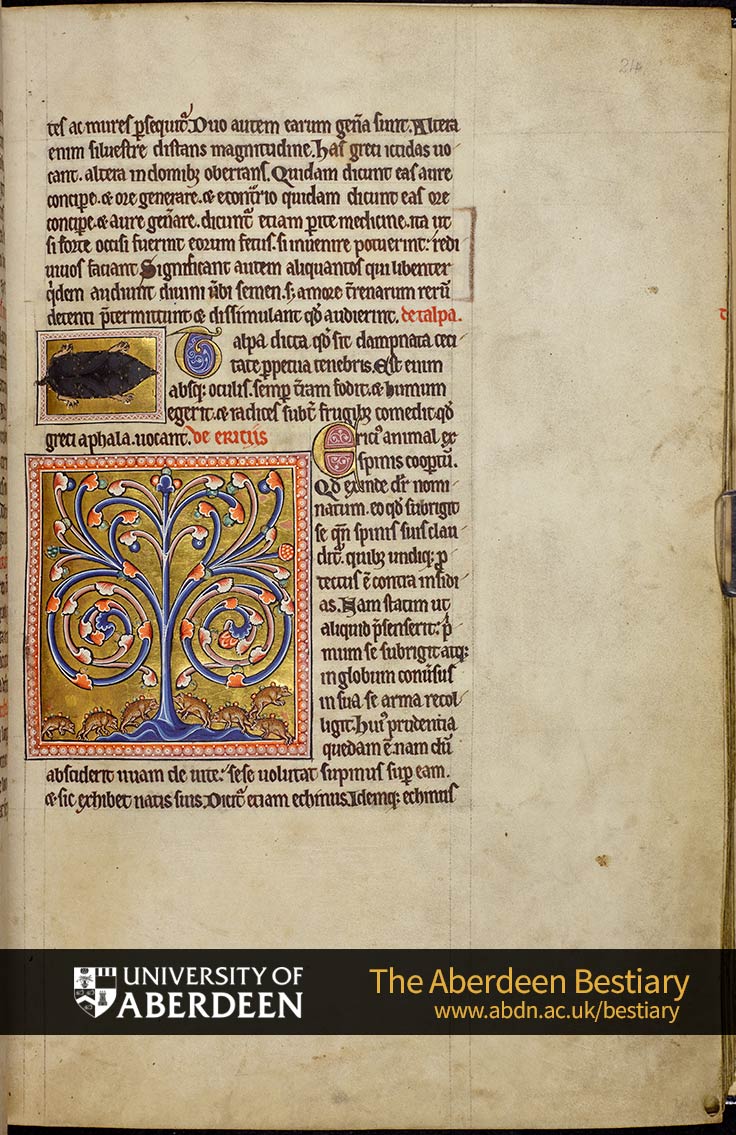Folio 24r - the weasel continued. De talpa; the mole. De ericiis; the hedgehog.
It hunts snakes and mice. There are two kinds of weasel. One, of very different size from the other, lives in the forest. The Greeks call these ictidas; the other roams around in houses. Some say that weasels conceive through the ear and give birth through the mouth; others say, on the contrary, that they conceive through the mouth and give birth through the ear; it is said, also, that they are skilled in healing, so that if by chance their young are killed, and their parents succeed in finding them, they can bring their offspring back to life.
Weasels signify the not inconsiderable number of people who listen willingly enough to the seed of the divine word but, caught up in their love of wordly things, ignore it and take no account of what they have heard.
Of the mole
The mole is called talpa because it is condemned to darkness by its permanent blindness. For it lacks eyes, eyeless, is always digging in the ground and throwing out the soil, and feeds on the the roots of the plants which the Greeks call aphala, vetch.
Of hedgehogs
The hedgehog is covered in prickles. From this it gets its name, because it bristles, when it is enclosed in its prickles and is protected by them on all sides against attack. For as soon as it senses anything, it first bristles then, rolling itself into a ball, regains its courage behind its armour. The hedgehog has a certain kind of foresight: as it tears off a grape, it rolls backwards on it and so delivers it to its young. It is also called echinus, urchin. This 'urchin',
- Commentary
-
Commentary
Text
The weasel continued. The blind mole. Hedgehogs.
Illustration
The mole has no eyes. The hedgehogs, covered in bristles, roll up in a ball, and carry grapes back to their young by impaling them on their spines.
Comment
Pricking for pouncing on the mole includes details of the shaded areas. Initial indicator 't' in red on right margin. Initials type 2.
Folio Attributes
- Transcription and Translation
-
Transcription
tes et mures persequitur. Duo autem earum genera sunt. Altera \enim silvestre distans magnitudine. Has Greci ictidas vo\cant, altera in domibus oberrans. Quidam dicunt eas aure \concipere et ore generare, et econtrario quidam dicunt eas ore \concipere et aure generare, dicuntur etiam perite medicine, ita ut \si forte occisi fuerint eorum fetus, si invenire potuerint, redi\vivos faciant. Significant autem aliquantos qui libenter \quidem audiunt divini verbi semen, sed amore terrenarum rerum \decenti pretermittunt et dissimulant quod audierint. \ De talpa \ Talpa dicta quod sit dampnata ceci\tate perpetua tenebris. Est enim \absque oculis, semper terram fodit, et humum \egerit, et radices subter frugibus comedit quod \Greci aphala vocant. \ De ericiis \ Ericius animal ex \spinis coopertum. \Quod exinde dicitur nomi\natum, eo quod subrigit \se quando spinis suis clau\ditur, quibus undique pro\tectus est contra insidi\as. Nam statim ut \aliquid presenserit, pri\mum se subrigit atque \in globum conversus \in sua se arma recol\ligit. Huius prudentia \quedam est, nam dum \absciderit uuam derute, sese volutat supinus super eam, \et sic exhibet natis suis. Dicitur etiam echinus. Idemque echinus \Translation
It hunts snakes and mice. There are two kinds of weasel. One, of very different size from the other, lives in the forest. The Greeks call these ictidas; the other roams around in houses. Some say that weasels conceive through the ear and give birth through the mouth; others say, on the contrary, that they conceive through the mouth and give birth through the ear; it is said, also, that they are skilled in healing, so that if by chance their young are killed, and their parents succeed in finding them, they can bring their offspring back to life. Weasels signify the not inconsiderable number of people who listen willingly enough to the seed of the divine word but, caught up in their love of wordly things, ignore it and take no account of what they have heard. Of the mole The mole is called talpa because it is condemned to darkness by its permanent blindness. For it lacks eyes, eyeless, is always digging in the ground and throwing out the soil, and feeds on the the roots of the plants which the Greeks call aphala, vetch. Of hedgehogs The hedgehog is covered in prickles. From this it gets its name, because it bristles, when it is enclosed in its prickles and is protected by them on all sides against attack. For as soon as it senses anything, it first bristles then, rolling itself into a ball, regains its courage behind its armour. The hedgehog has a certain kind of foresight: as it tears off a grape, it rolls backwards on it and so delivers it to its young. It is also called echinus, urchin. This 'urchin',

